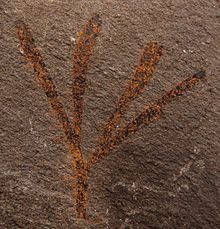Sphenobaiera (original) (raw)
From Wikipedia, the free encyclopedia
Form genus for fossil plant leaves
| _Sphenobaiera_Temporal range: Early Triassic–Late Cretaceous PreꞒ Ꞓ O S D C P T J K Pg N | |
|---|---|
 |
|
| Sphenobaiera digitata | |
| Scientific classification | |
| Kingdom: | Plantae |
| Division: | Ginkgophyta |
| Class: | Ginkgoopsida |
| Order: | Ginkgoales |
| Family: | incertae familiae |
| Genus: | _Sphenobaiera_Florin emend Harris & Millington[1] |
Sphenobaiera is a form genus for plant leaves belonging to the order Ginkgoales found in rocks from Triassic to Cretaceous periods. The genus Sphenobaiera is used for plants with wedge-shaped leaves that can be distinguished from Ginkgo, Ginkgoites and Baiera by the lack of a petiole.[1] It became extinct about 72.6 million years ago. The family to which this genus belongs has not been conclusively established; an affinity with the Karkeniaceae has been suggested on morphological grounds.[2]
Sphenobaiera ikorfatensis (Seward) Florin f. papillata Samylina has been found in Lower Cretaceous formations of Western Greenland, the Upper Jurassic of the Asiatic USSR, Upper Triassic, Lower Jurassic in Iran and the basal rock unit of the Lakota formation of the Black Hills, which Fontaine considered to be of Lower Cretaceous age. It is a ginkgophyte.[3]
Sphenobaiera has also been found in the Upper Triassic period Santa Maria Formation of Brazil.[4]
- ^ a b Susannah J. Lydon, Joan Watson & Nicola A. Harrison (2003). "The lectotype of Sphenobaiera ikorfatensis (Seward) Florin, a ginkgophyte from the Lower Cretaceous of western Greenland". Palaeontology. 46 (2): 413–421. Bibcode:2003Palgy..46..413L. doi:10.1111/1475-4983.00304.
- ^ Wang, Yongdong; et al. (April 2005). "Cuticular Anatomy of Sphenobaiera Huangii (Ginkgoales) from the Lower Jurassic of Hubei, China" (PDF embedded in HTML). American Journal of Botany. 92 (4): 709–721. doi:10.3732/ajb.92.4.709. PMID 21652450.
- ^ Elizabeth J. Cahoon (1960). "Sphenobaiera ikorfatensis f. papillata from the Lakota Formation of the Black Hills". Bulletin of the Torrey Botanical Club. 87 (4): 247–257. doi:10.2307/2482869. JSTOR 2482869.
- ^ Passo das Tropas, Santa Maria, RS. Marco bioestratigráfico triássico na evolução paleoflorística do Gondwana na Bacia do Paraná